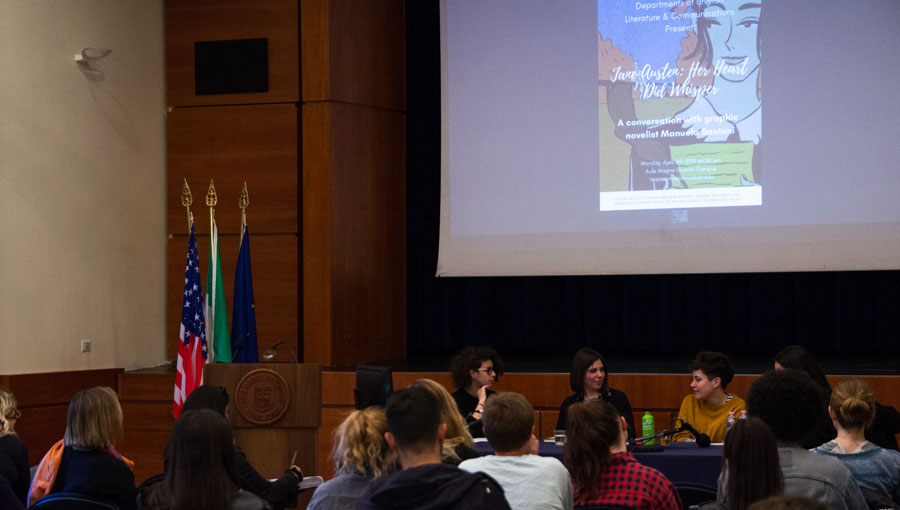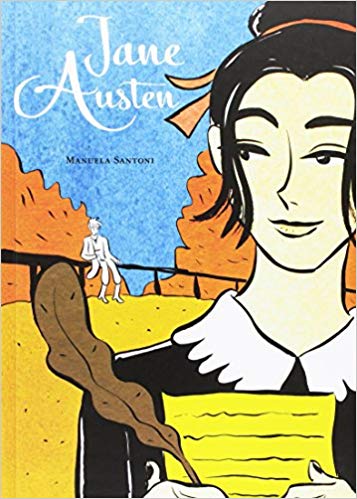Jane Austen's Heart Did Whisper: Graphic Novelist Manuela Santoni

Manuela Santoni speaking of her book on Jane Austen
“Compelling stories write themselves.” – Manuela Santoni
John Cabot University, in collaboration with the Department of English Literature and Communications, welcomed Manuela Santoni on April 9. Santoni is the author of a graphic novel on Jane Austen published by Becco Giallo in 2016.
Santoni started off by saying that she has loved drawing and writing since she was a child, which is why she decided to combine her two biggest passions into a graphic novel. After attending a school for cartooning, Santoni realized that she wasn’t interested in doing anything mainstream like working for Marvel. She felt the need to do something more personal and unique, so she started looking for publishers who would support a new project in the Italian landscape. Graphic novels have long been popular in the U.S. and in the Francophone world, but are a recent phenomenon in Italy.
Right before Santoni started writing what was to become her first graphic novel, the publisher told her that the book had to be for everyone; in other words, she was told not to target a specific audience. For this reason, Jane and the other characters don’t use early 19th century language, but speak in a modern way. Since the book was also meant to be used in schools, Santoni chose not to write about Jane Austen’s whole life, but to concentrate on the period from her childhood to her 21st birthday when she crafted Pride and Prejudice. Santoni made this choice because she felt that this was the most important time for Austen because it was then that she developed her passion and “calling” for writing.
Everything that we know about Jane Austen comes from the letters that she wrote to her sister Cassandra. When Austen died in 1817, most of the letters were burned. Therefore, many scholars have tried to fill in the gaps in these missing documents. When Santoni began working on the graphic novel, she realized that she had to work with those missing pieces. The main problem was that the theme of Santoni’s graphic novel was not Jane Austen’s books but Jane Austen herself. At that point, she really had to enter into a world of fantasy and imagination.
According to Santoni, being a female author in Italy is challenging not only because graphic novels are still pretty new in the Italian market, but also because it’s only been a few years since Italians have realized that women write graphic novels too. Today there are many women who write graphic novels and she is proud to be one of them.
Santoni says that she considers herself a feminist and she believes that in some ways Austen can be considered a feminist. For example, she sacrificed marriage fundamentally because she wanted to write. Santoni continued by explaining that through her novels, Austen described the social dynamics of her time. The women that she portrays in her novels are ultra-modern because they are at the same level as the male characters in terms of intelligence and dignity, although they were still burdened with the same requirements that the society of the time required of women.
Another important element in Jane Austen’s stories was money. Back in the 19th century, families pushed their daughters into marriage at a young age so that could start their own family and stop being economically sustained by their parents.

Jane Austen – Manuela Santoni
During her research for the book, Santoni found a lot of historical images of Austen that she used to make her drawings. At that point, Santoni realized that it wasn’t “her Jane Austen,” which is why she decided to let herself go a little bit and free herself up to make the design a little simpler. Santoni’s design is a blend of European comic style and Manga in black and white. She explained that the real difficulty wasn’t figuring out how to portray Austen, which came quite naturally, but convincing her publisher to let the comics be in black and white, which according to Santoni allows the reader to interpret the colors.
In her graphic novel, Santoni wanted to tell the story of the intimate moments that women often have, which is why she decided to portray Austen with her hair wild and loose while writing. Women at that time lived most of their lives in domestic environments and this was something that Santoni really wanted to speak about. Santoni claimed that she drew Jane with her hair unkempt so that we could have a better understanding of her strong personality.
Santoni concluded by giving a few tips to anyone considering becoming a graphic novelist. First, she explained that becoming a graphic novelist is very difficult, both because it is a job that has only been in existence for a short time and because it is not very lucrative. However, Santoni believes that it’s very important to follow your passions and dreams. The key to success in this field, just like in any other, is to never stop striving to see your desires become a reality.





